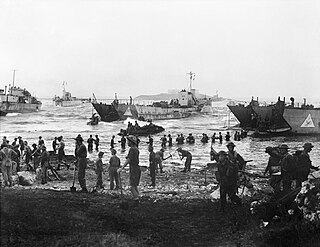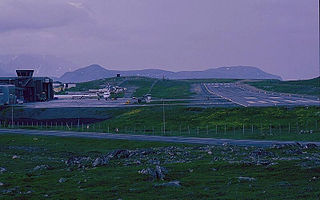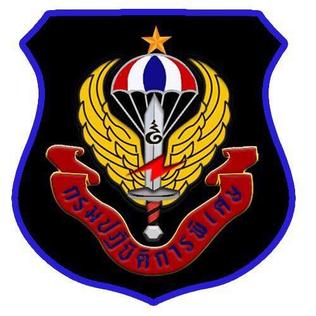
Airborne forces are ground combat units carried by aircraft and airdropped into battle zones, typically by parachute drop. Parachute-qualified infantry and support personnel serving in airborne units are also known as paratroopers.

A heliport, sometimes termed a vertiport, is a small airport suitable for use by helicopters and various types of vertical lift aircraft. Designated heliports typically contain one or more touchdown and liftoff areas and may also have limited facilities such as fuel or hangars. In some larger towns and cities, customs facilities may also be available.

A beachhead is a temporary line created when a military unit reaches a landing beach by sea and begins to defend the area as other reinforcements arrive. Once a large enough unit is assembled, the invading force can begin advancing inland. The term is sometimes used interchangeably with bridgehead and lodgement. Beachheads were important in many military actions; examples include operations such as Operation Neptune during World War II, the Korean War, and the Vietnam War.

A drop zone (DZ) is a place where parachutists or parachuted supplies land. It can be an area targeted for landing by paratroopers and airborne forces, or a base from which recreational parachutists and skydivers take off in aircraft and land under parachutes. In the latter case, it is often beside a small airport, frequently sharing the facility with other general aviation.
In military strategy, a bridgehead is the strategically important area of ground around the end of a bridge or other place of possible crossing over a body of water which at time of conflict is sought to be defended or taken over by the belligerent forces.

Air assault is the movement of ground-based military forces by vertical take-off and landing (VTOL) aircraft, such as helicopters, to seize and hold key terrain that has not been fully secured, and to directly engage enemy forces behind enemy lines. In addition to regular infantry training, air-assault units usually receive training in rappelling, fast-roping techniques, and air transportation. Their equipment is sometimes designed or field-modified to allow better transportation and/or carrying within aircraft.

USS Shasta (AE-33) was a Kilauea-class replenishment ammunition ship of the United States Navy. She was named after Mount Shasta, a volcano in the Cascade Range in northern California. Shasta's mission was to support forward deployed aircraft carrier battle groups, which she accomplished through underway replenishment and vertical replenishment. Over three decades, Shasta and her crew took part in the Vietnam War, the Cold War, the Iran–Iraq War, Desert Shield/Operation Desert Storm, and numerous other actions.

A landing operation is a military operation during which a landing force, usually utilizing landing craft, is transferred to land with the purpose of power projection ashore. With the proliferation of aircraft, a landing may refer to amphibious forces, airborne forces, or a combination of both.

An airlift is the organized delivery of supplies or personnel primarily via military transport aircraft.

A lodgement or lodgment is an enclave, taken and defended by force of arms against determined opposition, made by increasing the size of a bridgehead, beachhead, or airhead into a substantial defended area, at least the rear parts of which are out of direct line of fire. An example is Operation Overlord, the establishment of a large-scale lodgement in Normandy during World War II.

Hammerfest Airport is a regional airport at Prærien just outside the town of Hammerfest in Hammerfest Municipality in Finnmark county, Norway. It is operated by the state-owned Avinor and handled 145,396 passengers in 2014, making it the third-busiest regional airport in the country. The airport has a 880-meter (2,890 ft) runway aligned 05/23. Services are provided by Widerøe using the Dash 8-100. Up to eight daily flights are provided to Tromsø and public service obligation flights are flown eastwards to other airports in Finnmark. The airport is the base for offshore helicopter services operated by Bristow Norway and CHC Helikopter Service. An estimated 40,000 people from Hammerfest Airport's catchment area annually use Alta Airport for flights to Oslo.

The National Gendarmerie is one of two national law enforcement forces of France, along with the National Police. The Gendarmerie is a branch of the French Armed Forces placed under the jurisdiction of the Ministry of the Interior, with additional duties from the Ministry of Armed Forces. Its responsibilities include policing smaller towns, suburbs and rural areas, crowd and riot control, criminal investigation, including cybercrime. By contrast, the National Police is a civilian law enforcement agency that is in charge of policing cities and larger towns. Because of its military status, the Gendarmerie also fulfills a range of military and defence missions. The Gendarmerie has a strength of around 102,269 people.

Luhansk International Airport was an airport in Luhansk, Ukraine. The airport was located 20 km south of the city center, 9 km to the city limit. Since 11 June 2014, the airport has been officially closed. It was mostly destroyed during the war in Donbas.
Braathens Helikopter A/S was a Norwegian helicopter airline based at Stavanger Airport and Bergen Airport. It used a fleet of seven Aérospatiale Super Pumas to serve offshore oil platforms in the North Sea. The customers were Amoco, BP, Norsk Hydro, Phillips Petroleum and Statoil, serving their oil fields Ekofisk, Oseberg, Gullfaks, Veslefrikk, Valhall, Ula and Gyda. Braathens Helikopter operated from 1989 to 1993, after which it was sold to and merged with the main competitor, Helikopter Service. Braathens Helikopter was owned by Ludvig G. Braathens Rederi and was a sister company of the airline Braathens SAFE.
Valence - Chabeuil Airport is an airport in France, located about 5 miles (8 km) east of Valence and approximately 300 miles (483 km) south-southeast of Paris.
Exercise SWARMER was a large-scale military exercise conducted in the spring of 1950 by the United States Air Force, United States Army, and United States Navy in the area of Fort Bragg, North Carolina in the southeastern United States. SWARMER was designed to test the capability of the Air Force and Army to operate and maintain an airhead, a base secured in enemy territory where troops and supplies could be received and evacuated by air, under simulated combat conditions. This was also the first tactical use of the strategic airlift technique, intending to apply lessons learned during the Berlin Airlift to battlefield logistics.
Landing area is an official designation of specialized Earth surface region by the international standard publication describing airfields and airports to aviators, the Aeronautical Information Publication. As such, it is directly translated into dozens of languages, wherever an AIP publication exists, which is one for every aviation-regulating country of the world. It is the most salient description of the logistics real estate which enable planes or helicopters or other aircraft to come and go. It also has other meanings, which extend beyond aviation concepts and airport terminology, all of them military in kind.

The Royal Thai Air Force Special Operations Regiment or Air Force Commando is the tier-one special forces in the Royal Thai Air Force Security Force Regiment's Special Combat Operations Squadron, which has been in existence since late 1975. Part of Royal Thai Air Force, they are based near Don Mueang International Airport and provide anti-hijacking capabilities, combat search and rescue, commando style raids, executive protection, forward air control, hostage rescue, irregular warfare, medical evacuation, providing security at air base or international airport, special operations mission, and tactical emergency medical services.
The Battle of Kunduz took place between the Afghan National Security Forces (ANSF) and the Taliban for control of the city of Kunduz. The fighting started in late June and lasted until the city was overrun by the Taliban on 8 August. The Afghan government forces, defending the city, withdrew to 217th Pamir Corps headquarters and airport within the city. After resisting for three days, an entire 217th Pamir Corps had surrendered, allowing Taliban to take control of the airport and a number of military vehicles and tanks stationed inside the headquarters.

The Battle of Antonov Airport, also known as the battle of Hostomel Airport, was a military engagement which occurred at the Antonov Airport in Hostomel, Kyiv Oblast, during the Kyiv offensive of the Russian invasion of Ukraine.














